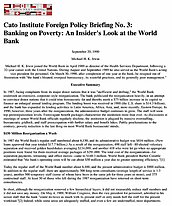Banking on Poverty: An Insider’s Look at the World Bank
In 1987, facing complaints from its major donor nations that it was “inefficient and drifting,” the World Bank undertook an extensive, corporate-style reorganization. The bank publicized the reorganization heavily, in an attempt to convince donor nations that it could trim bureaucratic fat and thereby merit a $75 billion increase in its capital to finance an enlarged annual lending program. The funding boost was received in 1988 (the U.S. share is $14.3 billion), and the bank has expanded its lending activities in Latin America, Africa, Asia, and, more recently, Eastern Europe. In 1990, however, three years after the reorganization, the administrative budget continues to grow. The staff will soon top prereorganization levels. Extravagant benefit packages characterize the institution more than ever. As discussions at meetings of senior World Bank officials regularly disclose, the institution is plagued by massive overstaffing, bureaucratic gridlock, and staff preoccupation with further salary and benefit hikes. Public proclamations to the contrary, poverty reduction is the last thing on most World Bank bureaucrats’ minds.
About the Author

This work is licensed under a Creative Commons Attribution-NonCommercial-ShareAlike 4.0 International License.
